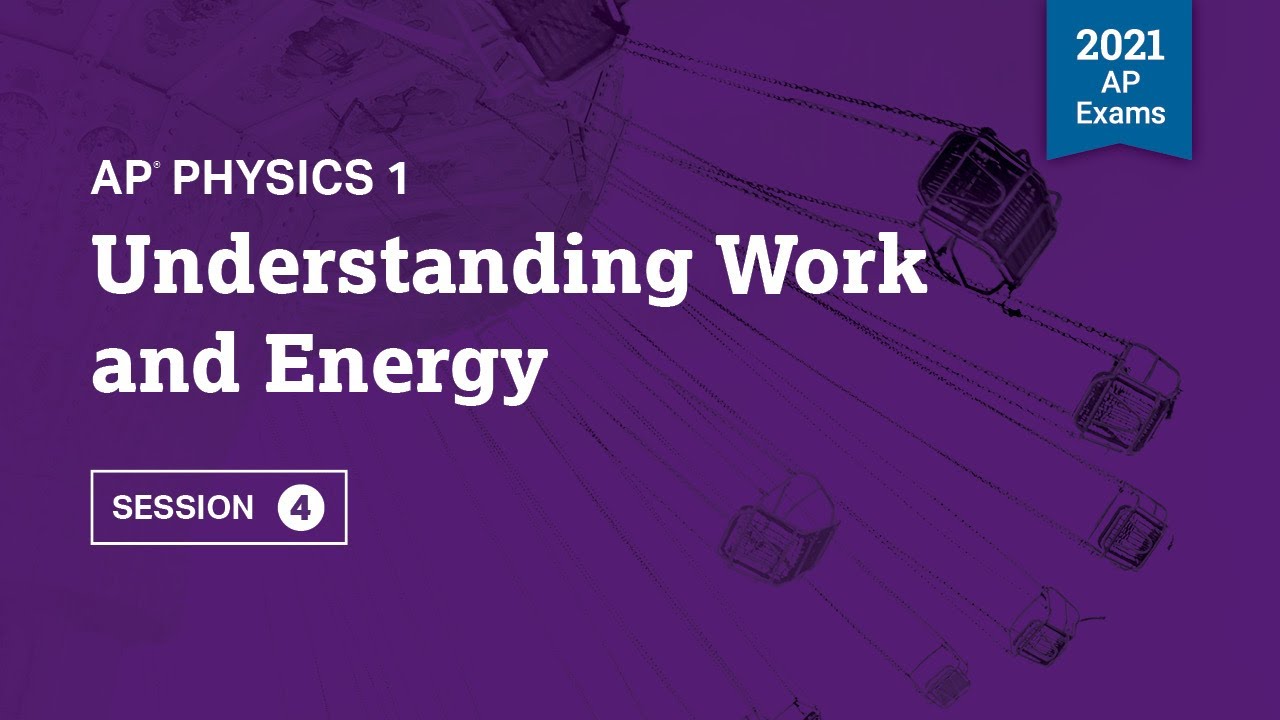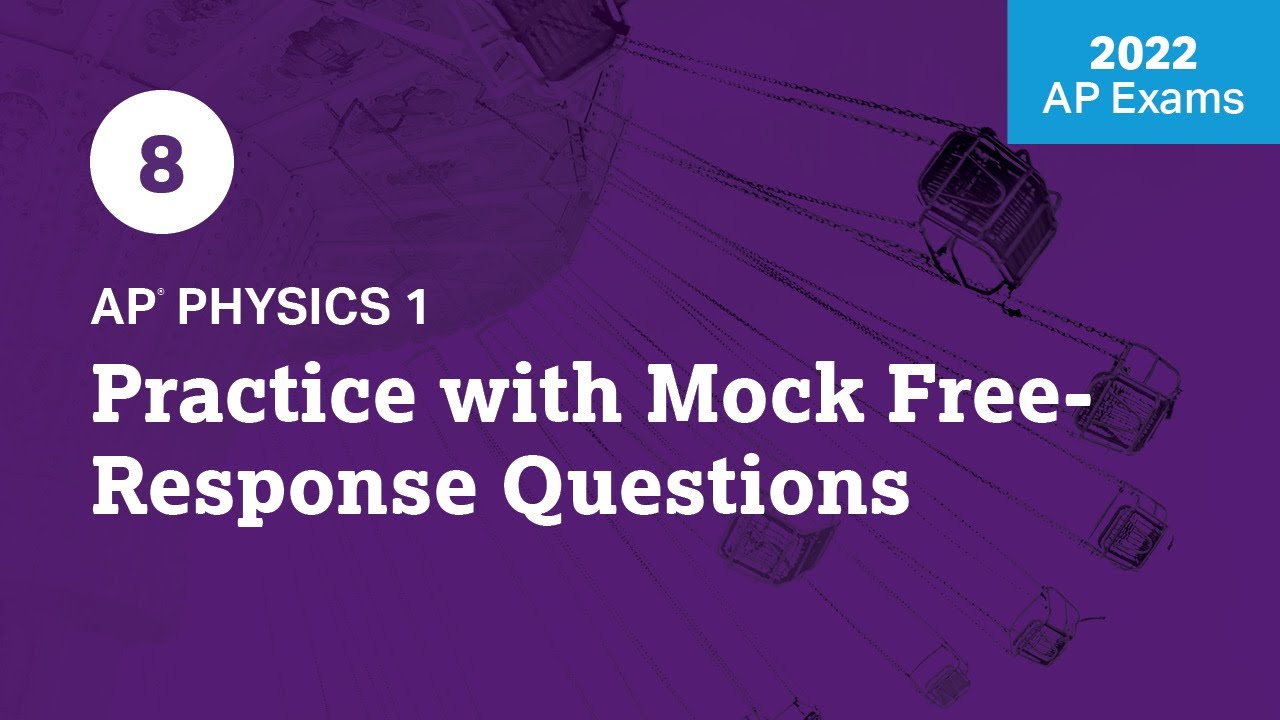3 | FRQ (Question 1: Experimental Design) | Practice Sessions | AP Physics 1
TLDRIn this AP Daily Practice Session, Kristin Gonzalez-Vega from Centennial High School in Frisco, Texas, guides students through the experimental design question from the 2022 AP Physics 1 Exam, focusing on question number 3. She emphasizes the importance of understanding systems, listing relevant equipment, and measuring quantities accurately. Kristin provides detailed tips on reducing uncertainty in experiments, such as repeating trials and varying heights for a clear trend. She also explains how to calculate kinetic and potential energy, and how to represent these on a graph. Additionally, she demonstrates how to determine the rotational inertia of a wheel using angular velocity data, highlighting the need for precise graphing techniques and the application of physical formulas.
Takeaways
- 📝 The focus of the session is on experimental design for AP Physics 1 Exam free response questions, specifically the 2022 exam question number 3.
- 🔍 The question involves analyzing the relationship between the decrease in potential energy and the increase in kinetic energy of a falling block.
- 🎯 Importance of clearly defining the system and its components when discussing energy conservation and potential vs. kinetic energy.
- 📈 The necessity of listing the correct equipment that corresponds to the measured quantities and the procedure to reduce uncertainty in experimental results.
- 🔬 Measuring the mass of the block with a balance, the distance it falls with a meter stick, and the time it takes to fall with a stopwatch are key steps in the experiment.
- 🔄 Repeating trials multiple times at the same height and varying heights helps to ensure accuracy and identify trends in the data.
- 📊 Including a simple diagram in the procedure aids in understanding the experimental setup and is beneficial for AP readers.
- 🏆 Scoring guidelines emphasize the use of relevant equipment, sufficient measurements for determining kinetic and potential energy, and a plausible procedure.
- 🏷️ The concept that the total mechanical energy of the system (translational + rotational kinetic energy) must equal the loss in gravitational potential energy is crucial.
- 📌 When graphing, a line or curve representing the rotational kinetic energy of the wheel as a function of the block's falling distance should be added to the graph of gravitational potential energy change.
- 🔢 Calculating the rotational inertia of the wheel involves drawing a line of best fit through the data points and using the slope in the equation for rotational kinetic energy.
Q & A
What is the main topic of the video?
-The main topic of the video is the experimental design question from the 2022 AP Physics 1 Exam, specifically focusing on question number 3.
What aspect of energy are the students in the video discussing?
-The students are discussing the relationship between the decrease in potential energy and the increase in the block's kinetic energy as it falls.
What is the significance of systems in this context?
-Systems are important because they help determine what is included in the analysis. In this case, the system consists of the block, the wheel, and the Earth.
How does the video emphasize the importance of measurement in experimental design?
-The video emphasizes that measurements should be directly taken with the appropriate equipment and that the quantities measured must align with the equipment used.
What is the purpose of repeating experiments multiple times in the context of reducing uncertainty?
-Repeating experiments multiple times helps ensure that the results are not due to chance and increases the reliability of the findings by showing a consistent trend.
What is the relationship between average speed and final velocity in the context of the falling block?
-The final velocity is twice the average speed when an object is accelerating, so the average speed can be used to estimate the final velocity by doubling it.
How does the conservation of mechanical energy principle apply to the graph in the video?
-The conservation of mechanical energy principle states that the total mechanical energy (sum of kinetic and potential energy) must remain constant in an isolated system, which is reflected in the graph showing the loss of potential energy equaling the total gain in kinetic energy.
What is the significance of drawing a straight line that passes through the origin with a positive slope on the graph?
-Drawing such a line represents the rotational kinetic energy of the wheel as a function of the block's falling distance, assuming a constant rate of increase in the wheel's spinning speed.
How does the video instruct on determining the rotational inertia from the graph?
-The video instructs to use the slope of the line of best fit on the graph of rotational kinetic energy versus angular velocity squared. The slope is one half the rotational inertia (I), which can be calculated by multiplying the slope by 2.
What is the importance of using a ruler when drawing a line of best fit?
-Using a ruler ensures a straight line, which is necessary for accurately representing the data and obtaining a reliable line of best fit for analysis.
What are some tips for drawing a line of best fit?
-Tips include using a ruler for straight lines, fitting the line to as many data points as possible both above and below the line, and not forcing the line through the origin unless there is a significant y-intercept.
Outlines
📚 Introduction to AP Physics 1 Exam - Free Response Question Strategy
This paragraph introduces the video's focus on tackling a free response question from the AP Physics 1 Exam, specifically the experimental design question. The speaker, Kristin Gonzalez-Vega, encourages viewers to review previous videos for context and introduces the 2022 exam's question number 3. The emphasis is on understanding the question, applying correct procedures, and using appropriate equipment to measure quantities like gravitational potential energy and translational kinetic energy. Tips are provided on how to effectively communicate the experimental setup, the importance of systems in physics problems, and the need to reduce uncertainty by conducting multiple trials.
🎯 Scoring Guidelines and Action Verbs in Physics
In this paragraph, the focus shifts to the importance of action verbs in the context of the scoring guidelines for the AP Physics 1 Exam. It is emphasized that understanding and using the correct action verbs is crucial for explaining the physics concepts and procedures accurately. The speaker explains how to determine kinetic energy using the quantities measured and clarifies the misconception between average speed and final velocity. The paragraph also discusses how to earn points by correctly identifying the needed quantities, using the kinetic energy equation, and specifying that the velocity in the equation should be the final velocity immediately before the object reaches the floor.
📈 Graphing and Calculating Rotational Inertia
The final paragraph delves into the specifics of graphing rotational kinetic energy as a function of the angular velocity squared and calculating the rotational inertia of the wheel. The speaker provides detailed instructions on how to draw a line of best fit using a ruler and how to distribute data points evenly above and below this line. The concept of not forcing the line through the origin is also discussed. The speaker then explains how to use the slope of this line to calculate the rotational inertia, emphasizing the need to show work and ensure that the final answer includes correct units. Points are awarded for correctly calculating the slope, relating it to rotational inertia, and providing a numerical value consistent with the calculated slope.
Mindmap
Keywords
💡Experimental Design
💡Free Response Questions
💡Kinetic Energy
💡Potential Energy
💡Conservation of Energy
💡Translational Kinetic Energy
💡Rotational Kinetic Energy
💡Uncertainty Reduction
💡Procedure
💡Data Representation
💡Rotational Inertia
Highlights
Kristin Gonzalez-Vega from Centennial High School hosts an AP Daily Practice Sessions focusing on free response questions.
The session specifically addresses the experimental design question from the 2022 AP Physics 1 Exam, question number 3.
Students are guided through comparing the increase in translational kinetic energy to the decrease in gravitational potential energy of the block-Earth system.
The importance of defining the system and its components is emphasized for accurate energy calculations.
A detailed procedure for measuring the mass of the block, the distance it falls, and the time it takes is provided.
The concept of reducing uncertainty by conducting multiple trials and ensuring repeatability in experiments is discussed.
The use of a diagram to aid AP readers in understanding the experimental setup is recommended.
The method for measuring the mass of the block using a balance, the distance with a meter stick, and time with a stopwatch is outlined.
The importance of aligning measured quantities with the appropriate equipment is stressed to avoid common mistakes.
The scoring guidelines for listing relevant equipment and measurements are explained, emphasizing the need for direct measurements, not calculations.
A step-by-step explanation of how to determine kinetic energy using measured quantities is provided.
The misconception between average speed and final velocity is clarified, with the correct method for finding the final velocity before impact discussed.
Instructions for scoring points by indicating that mass and velocity are needed for calculating kinetic energy are given.
The process of drawing a line or curve to represent the rotational kinetic energy of the wheel as a function of the block's falling distance is detailed.
The principle of conservation of mechanical energy is used to ensure the sum of potential and kinetic energy remains constant.
Guidelines for drawing a straight line with a ruler for a line of best fit are provided, emphasizing the importance of not forcing it through the origin.
The method for calculating the rotational inertia of the wheel using the slope of the line of best fit is explained, with the correct unit and value emphasized.
The session concludes with a recap of the tips provided and an invitation for viewers to return for more practice.
Transcripts
Browse More Related Video

1 | MCQ | Practice Sessions | AP Physics 1

2 | FRQ (Question 4/5: Short Answer) | Practice Sessions | AP Physics 1

2021 Live Review 4 | AP Physics 1 | Understanding Work and Energy

6 | FRQ (Question 2: Qualitative/Quantitative Translation) | Practice Sessions | AP Physics 1

2021 Live Review 8 | AP Physics 1 | Understanding Rotational Energy and Momentum

2022 Live Review 8 | AP Physics 1 | Practice with Mock Free-Response Questions
5.0 / 5 (0 votes)
Thanks for rating: